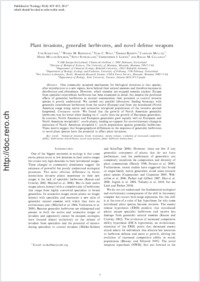Plant invasions, generalist herbivores, and novel defense weapons
- Schaffner, Urs CABI Europe-Switzerland, Delémont, Switzerland -
- Ridenour, Wendy M. Division of Biological Sciences, The University of Montana, Missoula, USA
- Wolf, Vera C. Department of Chemical Ecology, Bielefeld University, Germany
- Bassett, Thomas Division of Biological Sciences, The University of Montana, Missoula, USA
- Müller, Caroline Department of Chemical Ecology, Bielefeld University, Germany
- Müller-Schärer, Heinz Department of Biology, Ecology and Evolution, University of Fribourg, Switzerland
- Sutherland, Steve Fire Sciences Laboratory, Rocky Mountain Research Station, USDA Forest Service, Missoula, USA
- Lortie, Christopher J. Department of Biology, York University, Toronto, Canada
- Callaway, Ragan M. Division of Biological Sciences, The University of Montana, Missoula, USA
-
2011
Published in:
- Ecology. - 2011, vol. 92, no. 4, p. 829-835
biological invasions
biotic resistance
enemy release
evolution of increased competitive ability
herbivorous invertebrates
novel associations
plant–herbivore interactions
English
One commonly accepted mechanism for biological invasions is that species, after introduction to a new region, leave behind their natural enemies and therefore increase in distribution and abundance. However, which enemies are escaped remains unclear. Escape from specialist invertebrate herbivores has been examined in detail, but despite the profound effects of generalist herbivores in natural communities their potential to control invasive species is poorly understood. We carried out parallel laboratory feeding bioassays with generalist invertebrate herbivores from the native (Europe) and from the introduced (North America) range using native and nonnative tetraploid populations of the invasive spotted knapweed, Centaurea stoebe. We found that the growth of North American generalist herbivores was far lower when feeding on C. stoebe than the growth of European generalists. In contrast, North American and European generalists grew equally well on European and North American tetraploid C. stoebe plants, lending no support for an evolutionary change in resistance of North American tetraploid C. stoebe populations against generalist herbivores. These results suggest that biogeographical differences in the response of generalist herbivores to novel plant species have the potential to affect plant invasions.
- Faculty
- Faculté des sciences et de médecine
- Department
- Département de Biologie
- Language
-
- English
- Classification
- Ecology and biodeversity
- License
-
License undefined
- Identifiers
-
- RERO DOC 23207
- DOI 10.1890/10-1230.1
- Persistent URL
- https://folia.unifr.ch/unifr/documents/301882
Statistics
Document views: 137
File downloads:
- pdf: 214
